More actions
m →T'Shen |
|||
| (11 intermediate revisions by the same user not shown) | |||
| Line 9: | Line 9: | ||
Shi'Al is considered a province of contrasts. With most of its landmass located on or near the equator, it consists of vast areas of desert, among them the famous [[Sas-a-Shar|Forge]], but also the larger '''Cheleb-Kor'''. The wide stretch of the [[Llangon Mountains]] separating Shi'Al from [[Khomi]] and [[Gol]] is famous for an almost moderate climate and a variety of plant and animal life rivaled only by the [[T'Ralor]] preserve. Towards the East, the landscape is mostly scrubland, steppe and a savannah named '''Yartra Kin-kur''', with the latter gradually flowing into the rolling hills of [[Kir]]. The [[Arlanga Mountains|Heyalar t’Arlanga]] separate Southern Shi'Al from the former kingdom of Lhai (today a part of the province). The mountains, while not near as impressive as the [[Llangon Mountains|Heyalar t’L’langon]], still contain many microclimates, and the fertile foothills are dotted with farms. The northernmost region of Shi'Al is mostly flat grassland with a semiarid climate. | Shi'Al is considered a province of contrasts. With most of its landmass located on or near the equator, it consists of vast areas of desert, among them the famous [[Sas-a-Shar|Forge]], but also the larger '''Cheleb-Kor'''. The wide stretch of the [[Llangon Mountains]] separating Shi'Al from [[Khomi]] and [[Gol]] is famous for an almost moderate climate and a variety of plant and animal life rivaled only by the [[T'Ralor]] preserve. Towards the East, the landscape is mostly scrubland, steppe and a savannah named '''Yartra Kin-kur''', with the latter gradually flowing into the rolling hills of [[Kir]]. The [[Arlanga Mountains|Heyalar t’Arlanga]] separate Southern Shi'Al from the former kingdom of Lhai (today a part of the province). The mountains, while not near as impressive as the [[Llangon Mountains|Heyalar t’L’langon]], still contain many microclimates, and the fertile foothills are dotted with farms. The northernmost region of Shi'Al is mostly flat grassland with a semiarid climate. | ||
One of the most densely populated regions on [[Vulcan (Planet)|Vulcan]], Shi'Al is considered the planet's cultural center, but its famous | One of the most densely populated regions on [[Vulcan (Planet)|Vulcan]], Shi'Al is considered the planet's cultural center, but its famous capital [[Shi'Kahr]] is far from the only point of interest in this province of variety. | ||
==History== | ==History== | ||
| Line 57: | Line 57: | ||
One of [[Vulcan (Planet)|Vulcan]]'s oldest inhabited settlements, current capital of Shi'Al and legislative capital of Vulcan. Located near the edge of [[Sas-a-Shar|The Forge]], and in sight of the [[Llangon Mountains]] and Mount Tar'Hana. Towards the east, the desert and scrubland merge into the Yartra Kin-kur. | One of [[Vulcan (Planet)|Vulcan]]'s oldest inhabited settlements, current capital of Shi'Al and legislative capital of Vulcan. Located near the edge of [[Sas-a-Shar|The Forge]], and in sight of the [[Llangon Mountains]] and Mount Tar'Hana. Towards the east, the desert and scrubland merge into the Yartra Kin-kur. | ||
''For details please see separate article'' | |||
===[[Sas-a-Shar|The Forge]]=== | |||
A part of the larger region known as '''Pa’ash-Solektra t’Shvial''', the desert known by various names but colloquially referred to as 'The Forge' extends from [[Xial#Seleya|Seleya]] to within roughly 80 kilometers outside [[Shi'Kahr]]. | |||
Notable features include: | |||
* T’Karath | |||
* Plains of Blood | |||
* The Gateway | |||
''For details please see separate article'' | |||
[[Image:Cheleb Kor.jpg|200px|thumb|right|Cheleb Kor]] | [[Image:Cheleb Kor.jpg|200px|thumb|right|Cheleb Kor]] | ||
| Line 77: | Line 93: | ||
In the foothills of the [[Arlanga Mountains]] on the edge of the Cheleb-Khor Desert, the Temple of Anonak offered rest and healing to children who endured or were injured in the [[Kahs-wan|kahs-wan]] ritual. Each evening, the monks ventured out to search for the lost and bleeding. Today, search and rescue are still a part of the duties of the priests of Anonak. It continues to be a place of meditation and study open to all. | In the foothills of the [[Arlanga Mountains]] on the edge of the Cheleb-Khor Desert, the Temple of Anonak offered rest and healing to children who endured or were injured in the [[Kahs-wan|kahs-wan]] ritual. Each evening, the monks ventured out to search for the lost and bleeding. Today, search and rescue are still a part of the duties of the priests of Anonak. It continues to be a place of meditation and study open to all. | ||
===T'Shen=== | ===T'Shen=== | ||
| Line 88: | Line 102: | ||
Located in the [[Llangon Mountains|Heyalar t’L’langon]] southeast of [[Shi'Kahr]], T'Shen monastery is known as one of the few places to traditionally accept outworlders. The order is most famous for teaching the skills of healing trances, biofeedback, and neuropressure. | Located in the [[Llangon Mountains|Heyalar t’L’langon]] southeast of [[Shi'Kahr]], T'Shen monastery is known as one of the few places to traditionally accept outworlders. The order is most famous for teaching the skills of healing trances, biofeedback, and neuropressure. | ||
Set in a valley at an elevation of roughly 1000 meters above sea level, the monastery is constructed of the local honey-gold granite and marble, and the wood of the abundantly growing [[Ic'tan|ic'tan]] | Set in a valley at an elevation of roughly 1000 meters above sea level, the monastery is constructed of the local honey-gold granite and marble, and the wood of the abundantly growing [[Ic'tan|ic'tan]] and [[Sher'khah|sher'khah]] trees. | ||
The central complex is built in the light, elegant and simplistic style with marble foundations, wooden walls and large, gently curved roofs indicative of [[Khomi]]'s 3rd Age; giving credence to the theory that T'Shen might have been founded by healer monks from the neighboring province. The eastern wing overlooks a small mountain lake and shows signs of having been added roughly three centuries later to incorporate baths and storerooms for herbs and medicines. The central courtyard also appears a later addition, with open arcades enclosing a garden on three sides. | The central complex is built in the light, elegant and simplistic style with marble foundations, wooden walls and large, gently curved roofs indicative of [[Khomi]]'s 3rd Age; giving credence to the theory that T'Shen might have been founded by healer monks from the neighboring province. The eastern wing overlooks a small mountain lake and shows signs of having been added roughly three centuries later to incorporate baths and storerooms for herbs and medicines. The central courtyard also appears a later addition, with open arcades enclosing a garden on three sides. | ||
Several smaller buildings in the vicinity date back only three to four thousand years and show heavy influence of [[Kir]] architecture in their rounded doorways and windows. Most of these buildings house students or long term patients, or are used as | Several smaller buildings in the vicinity date back only three to four thousand years and show heavy influence of [[Kir]] architecture in their rounded doorways and windows. Most of these buildings house students or long term patients, or are used as classrooms. | ||
[[Image:T'Shen 02.jpg|thumb|right|gardens]] | |||
* '''Tow-kath''': the healing trance. Can at present only be taught to [[Vulcan (Species)|Vulcans]] with basic biofeedback skills. A self-induced trance that can give the physical appearance of near-death. Concentrates strength, blood, and antibodies onto injured organs and usually requires outside assistance to revive the patient. Advanced practitioners may induce micro-trances similar to deep meditation to assist with other healing techniques, or tend to non-critical injuries. | * '''Tow-kath''': the healing trance. Can at present only be taught to [[Vulcan (Species)|Vulcans]] with basic biofeedback skills. A self-induced trance that can give the physical appearance of near-death. Concentrates strength, blood, and antibodies onto injured organs and usually requires outside assistance to revive the patient. Advanced practitioners may induce micro-trances similar to deep meditation to assist with other healing techniques, or tend to non-critical injuries. | ||
* '''Ton'shu''' - Neuropressure. Most easily taught to tactile and/or telepathic species, but offered to any who wishes to learn. | * '''Ton'shu''' - Neuropressure. Most easily taught to tactile and/or telepathic species, but offered to any who wishes to learn. A combination of breathing exercises and postures to relieve or apply tension to specific parts of the body, inducing or assisting with self-healing. Full mastery of this technique may take years, however basic skills to aid with relaxation, pain relief, and some first aid procedures can be acquired over a one-year course. One well known basic technique of ton'shu is '''to'tsu'khy''', the 'nerve pinch' - it involves applying pressure near the base of the neck in order to near instantly render the target unconscious. | ||
===Oshi t’T’Vet=== | |||
Located in the foothills of the [[Llangon Mountains]], the Shrine of T’Vet is dedicated to one of the ancient war-goddesses of Vulcan. By some historians considered an offshoot of the ancient warrior-priest order of the [[V'Ket]], the soldier-monks were famous for their skills in unarmed combat, but also gained renown for deadly efficiency with the [[Ahn-woon|ahn-woon]]. | |||
In contrast to their purported forebears the followers of T'Vet preferred opulent surroundings, and the fortress-like shrine is considered a work of art, and a fine example of 4th dynasty architecture. The predominant colors are red and gold, as | |||
the goddess' face was believed to be reflected in [[T'Khut]], Vulcan’s sister planet. | |||
During the [[Time of Awakening]] the shrine was one of the focal points of resistance against [[Surak]]'s teachings, and it is believed that many followers of T'Vet eventually joined the [[The Sundering|Sekeikk'he]]. | |||
Today the monastery teaches self-defense arts and manufactures ceremonial weapons. | |||
===de’Khriv=== | |||
Presently located in central Shi'Al province, de’Khriv was formerly the capital of the '''Lhai''' nation but is best known as the home of [[Surak]] and possibly his birth place. Surak worked for a time as an accountant in his father’s firm located in the city. Today the city is the second largest population center of Shi'Al, overlooking the fertile '''Valley of Tsai`Kal'''. The botanical gardens of de’Khriv house the largest variety of [[Favinit|favinit]] orchids on the planet, and many IT and high-tech companies manitain headquerters in the city. | |||
===Da'Kum'Ulcha=== | |||
[[Image:City of Shadows.jpg|200px|thumb|left|City of Shadows]] | |||
The '''City of Shadows''', while certainly open to visitors, is not a subject many Vulcans like to talk about. It is left as a reminder of what happens when life comes to mean nothing, and the horrible consequences that often result. | |||
Da'Kum'Ulcha used to be called Devlarm, and had a population of just under one milion. Located in the nation of '''Lhai''' it was a center of technological research even prior to the [[Age of Expansion]], and it was here that the warlord Dvir financed and developed the first Vulcan ship capable of spaceflight. Being the first to reach space was seen by many of the other houses as the ultimate way to gain status and advantage, and most importantly first pick of the vast metal deposits of [[T'Khut]] and the Eridani system's asteroid belt. Fearing that '''Lhai''' would become the dominant power on [[Na'Nam]], the influential clans of the time jockeyed for influence, either by sabotage or negotioation. | |||
Before the ship could be commissioned, it – along with 90% of the city's population - were vaporized in a neutron blast by the warlord Nu’Val of Duveh (today located in the province of [[Raal]]). A gruesome testament to the precision of Vulcan weapons technology, most of the city itself remained intact, however it was never re-settled and even looters often fled the area quickly, claiming to have heard the sounds of the dying in the howling winds. | |||
Da'Kum'Ulcha is an archaeological site today, though the teams examining the ruins take great care to also treat the place with the respect owed a vast graveyard. | |||
[[Category: Vulcan (Planet)]] | [[Category: Vulcan (Planet)]] | ||
Latest revision as of 12:48, 20 November 2015
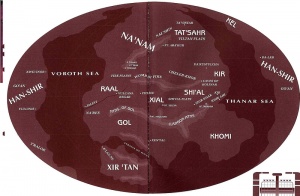
From SHai`aξ'àl'el (anc) - Place-of-rising (sun), morning
Bordered by the Llangon Mountains to the South, Xial to the West, Tat'Sahr to the North and Kir to the East, Shi'Al is a completely landlocked province except for a narrow stretch reaching towards roughly 50km of coastline. This small "buffer" area was ceded from Kir roughly 3000 years ago as part of an alliance, granting the largely trade-oriented Shi'Al clans direct access to the Thanar Sea.
Shi'Al is considered a province of contrasts. With most of its landmass located on or near the equator, it consists of vast areas of desert, among them the famous Forge, but also the larger Cheleb-Kor. The wide stretch of the Llangon Mountains separating Shi'Al from Khomi and Gol is famous for an almost moderate climate and a variety of plant and animal life rivaled only by the T'Ralor preserve. Towards the East, the landscape is mostly scrubland, steppe and a savannah named Yartra Kin-kur, with the latter gradually flowing into the rolling hills of Kir. The Heyalar t’Arlanga separate Southern Shi'Al from the former kingdom of Lhai (today a part of the province). The mountains, while not near as impressive as the Heyalar t’L’langon, still contain many microclimates, and the fertile foothills are dotted with farms. The northernmost region of Shi'Al is mostly flat grassland with a semiarid climate.
One of the most densely populated regions on Vulcan, Shi'Al is considered the planet's cultural center, but its famous capital Shi'Kahr is far from the only point of interest in this province of variety.
History
An often fractured and much fought for kingdom since antiquity, Shi'Al built much of its ancient wealth on trade, taking full advantage of its location between numerous rivaling clans. Renowned for both political acumen and skill at warfare, the ruling clans weathered millennia of wars and shifting alliances, and many of the planet's oldest families can still be found in this province.
One of the oldest known legends of Vulcan centers around the oasis at Shi'Kahr, then known only as Phelsh't (today's Pelasht), and the conquest of same by a desert-dwelling clan believed to first have evolved with the now common 'inner eyelid' (nictating membrane) that protects Vulcan eyesight from intense light and radiation.
The historical archives of the Science Academy also hold extensive volumes regarding the often tenuous relationship with Lhai and Xial, a strong rivalry of the ruling houses with Kir, which surprisingly rarely erupted into more than border skirmishes, and the by now legendary struggles with the powerful Raal.
F'hauúkh-ar Eξhìkh - The Desert Wars
Historical sources point to border wars with nomadic tribes from Xial dating back to the 35th century (roughly 6500 BCE Federation Standard). The existence of a separate clan inhabiting the forbidding, hostile environment of Sas-a-Shar (today generally referred to as The Forge) is a historical fact, though in earliest sources these Vulcans are often considered little more than myth, or at best uncouth, half-wild barbarians.

With the emergence and growth of settlements all across the province and consolidation of resources by the most powerful clans, the protection of caravanserais, outlying villages and trade routes became a matter of serious concern. While the nomadic tribes saw the villages near or within their borders an encroachment upon their territory, the ruling clans considered the uncivilized desert-dwellers a threat to their wealth and position. Consequently, several forts and strongholds were established across Western Shi'Al, however retaliatory strikes against raiding nomads most often ended in troops returning without ever having caught sight of the enemy.
Leading archaeologists believe the original purpose of the famous T'Karath Sanctuary to have been a fortress to guard against the Sas-a-Shar clan and the Xial nomads, and later a staging point for campaigns against both. Several artifacts and a recently uncovered tomb of a warlord dating back to the 37th century strongly support this notion.
Only marginally significant on a political scale, the F'hauúkh-ar Eξhìkh are the subject of much ancient poetry and prose, and as such considered of cultural importance. The theme of a milennia-long struggle, with nomadic tribes fighting well equipped, superior forces to a standstill over and over is one found on many other worlds; but set in Vulcan's violent splendor the inevitably tragic outcomes have inspired great works of art even from cultures not native to the Vulcan homeworld.
Kir - War and Peace
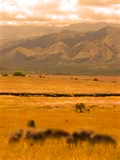
The relationship between these neighboring provinces has often been described as a living example of the human proverb "Keep your friends close and your enemies closer". While decidedly smaller and with fewer natural resources than Shi'Al, the ancient nation of Kir nonetheless resisted any attempts at conquest. Consequently, many high houses of Shi'Al sought alliances with the two major clans, and through the millennia these extensive entanglements often led to enthusiastic infighting between both Shi'Al and Kir houses over advantageous alliances, or perceived slights.
Until the Age of Expansion most of these skirmishes remained limited to clan feuds, but with advances in weapons technology and many Shi'Al houses attempting to widen their sphere of influence - as well as laying claim to resources needed to hold the powerful rival Raal at bay - several attempts to annex Kir's fertile regions and trading centers erupted into open warfare.
Surprised at the ferocity of the often deemed decadent and unorganized Kir clans, the major clans once more agreed on a settlement with their Eastern neighbors, one of them eventually securing an alliance with one of the high houses which gave them not only access to the Thanar Sea but favored trade status.
While smaller skirmishes should continue until the time of Surak, the alliances held through many upheavals and are part of the reason why none of the most devastating later wars touched Eastern Shi'Al or Kir.
The Rivals of Na'Nam
Separated by the desert-province of Xial, the ruling clans of Raal and Shi'Al had only sporadic - and mostly firnedly - interaction throughout antiquity, when the immediate threat was your neighbor who competed with you for water and food, but the stranger from afar was greeted with interest. This should change however with the rise of Shi'Al to a trade power in its own right, and the advent of technology.
Most of the larger - and most devastating - engagements occurred during the Age of Expansion, but historical sources as well as literature and art date the by now legendary power struggle to have begun millennia earlier. By virtue of alliances with Kir and betimes Khomi, exceptional skill at economic warfare, and not least of all the 'buffer' provided by Xial, the high houses managed to hold their own against the larger, powerful rival, albeit often at great cost.
Perhaps the only thing that prevented the major clans of the two provinces from mutual annihilation was the common threat of Tat'Sahr, the third major power on the continent, and the Vulcan propensity for spreading their warfare in a democratic manner - meaning, there was so much of it that focusing on but one rival at a time was the fastest way to have a third party take cheerful advantage.
Places of Note
Shi'Kahr
One of Vulcan's oldest inhabited settlements, current capital of Shi'Al and legislative capital of Vulcan. Located near the edge of The Forge, and in sight of the Llangon Mountains and Mount Tar'Hana. Towards the east, the desert and scrubland merge into the Yartra Kin-kur.
For details please see separate article
The Forge
A part of the larger region known as Pa’ash-Solektra t’Shvial, the desert known by various names but colloquially referred to as 'The Forge' extends from Seleya to within roughly 80 kilometers outside Shi'Kahr.
Notable features include:
- T’Karath
- Plains of Blood
- The Gateway
For details please see separate article

Cheleb-Kor
A large desert named after Ket-cheleb, the ancient god of anger. Located just north of the Heyalar t'Arlanga, it is famous for its red volcanic sands and bizarre lava formations.
Despite the harsh conditions, Cheleb-Kor and its surrounding regions sustains many animals, including vra'alen, tsh'in, shatarr and the rare lanka-gar. Drought-adapted shrubs in the desert include kala, rishtik and alem-vedik, and the northern regions contain vast stretches of dun-yar grass.
The southwestern portion contains tin, zinc, copper and gold deposits and was mined extensively throughout history. Cheleb-Kor gems mined in the foothills of Arlanga have been prized across the planet, with the most famous being the rubies and garnets.
Once completely within the borders of the Lhai nation, Cheleb-Kor is believed to have been the location of Surak's kahs-wan.
Tauklar t’Kulvir
The old lava tubes of a now inactive volcano, known as The Caves of Kulvir, were once used to tunnel foot and pack-animal traffic from the old capital of Lhai de’Khriv to the Temple of Anonak and the desert beyond. Today the intriguing rock formations and the ruins of an ancient temple destroyed by lava make the caves a popular tourist destination for day-hikers.
Anonak
In the foothills of the Arlanga Mountains on the edge of the Cheleb-Khor Desert, the Temple of Anonak offered rest and healing to children who endured or were injured in the kahs-wan ritual. Each evening, the monks ventured out to search for the lost and bleeding. Today, search and rescue are still a part of the duties of the priests of Anonak. It continues to be a place of meditation and study open to all.
T'Shen
Ti'ξyàhn (anc.)- in a high place (lit. lies-ascended)
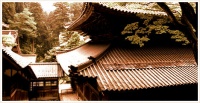
Located in the Heyalar t’L’langon southeast of Shi'Kahr, T'Shen monastery is known as one of the few places to traditionally accept outworlders. The order is most famous for teaching the skills of healing trances, biofeedback, and neuropressure.
Set in a valley at an elevation of roughly 1000 meters above sea level, the monastery is constructed of the local honey-gold granite and marble, and the wood of the abundantly growing ic'tan and sher'khah trees.
The central complex is built in the light, elegant and simplistic style with marble foundations, wooden walls and large, gently curved roofs indicative of Khomi's 3rd Age; giving credence to the theory that T'Shen might have been founded by healer monks from the neighboring province. The eastern wing overlooks a small mountain lake and shows signs of having been added roughly three centuries later to incorporate baths and storerooms for herbs and medicines. The central courtyard also appears a later addition, with open arcades enclosing a garden on three sides.
Several smaller buildings in the vicinity date back only three to four thousand years and show heavy influence of Kir architecture in their rounded doorways and windows. Most of these buildings house students or long term patients, or are used as classrooms.
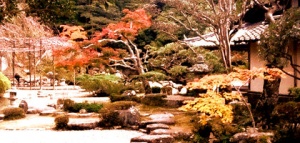
- Tow-kath: the healing trance. Can at present only be taught to Vulcans with basic biofeedback skills. A self-induced trance that can give the physical appearance of near-death. Concentrates strength, blood, and antibodies onto injured organs and usually requires outside assistance to revive the patient. Advanced practitioners may induce micro-trances similar to deep meditation to assist with other healing techniques, or tend to non-critical injuries.
- Ton'shu - Neuropressure. Most easily taught to tactile and/or telepathic species, but offered to any who wishes to learn. A combination of breathing exercises and postures to relieve or apply tension to specific parts of the body, inducing or assisting with self-healing. Full mastery of this technique may take years, however basic skills to aid with relaxation, pain relief, and some first aid procedures can be acquired over a one-year course. One well known basic technique of ton'shu is to'tsu'khy, the 'nerve pinch' - it involves applying pressure near the base of the neck in order to near instantly render the target unconscious.
Oshi t’T’Vet
Located in the foothills of the Llangon Mountains, the Shrine of T’Vet is dedicated to one of the ancient war-goddesses of Vulcan. By some historians considered an offshoot of the ancient warrior-priest order of the V'Ket, the soldier-monks were famous for their skills in unarmed combat, but also gained renown for deadly efficiency with the ahn-woon.
In contrast to their purported forebears the followers of T'Vet preferred opulent surroundings, and the fortress-like shrine is considered a work of art, and a fine example of 4th dynasty architecture. The predominant colors are red and gold, as the goddess' face was believed to be reflected in T'Khut, Vulcan’s sister planet.
During the Time of Awakening the shrine was one of the focal points of resistance against Surak's teachings, and it is believed that many followers of T'Vet eventually joined the Sekeikk'he.
Today the monastery teaches self-defense arts and manufactures ceremonial weapons.
de’Khriv
Presently located in central Shi'Al province, de’Khriv was formerly the capital of the Lhai nation but is best known as the home of Surak and possibly his birth place. Surak worked for a time as an accountant in his father’s firm located in the city. Today the city is the second largest population center of Shi'Al, overlooking the fertile Valley of Tsai`Kal. The botanical gardens of de’Khriv house the largest variety of favinit orchids on the planet, and many IT and high-tech companies manitain headquerters in the city.
Da'Kum'Ulcha
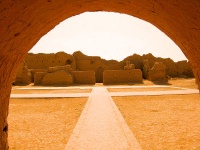
The City of Shadows, while certainly open to visitors, is not a subject many Vulcans like to talk about. It is left as a reminder of what happens when life comes to mean nothing, and the horrible consequences that often result.
Da'Kum'Ulcha used to be called Devlarm, and had a population of just under one milion. Located in the nation of Lhai it was a center of technological research even prior to the Age of Expansion, and it was here that the warlord Dvir financed and developed the first Vulcan ship capable of spaceflight. Being the first to reach space was seen by many of the other houses as the ultimate way to gain status and advantage, and most importantly first pick of the vast metal deposits of T'Khut and the Eridani system's asteroid belt. Fearing that Lhai would become the dominant power on Na'Nam, the influential clans of the time jockeyed for influence, either by sabotage or negotioation.
Before the ship could be commissioned, it – along with 90% of the city's population - were vaporized in a neutron blast by the warlord Nu’Val of Duveh (today located in the province of Raal). A gruesome testament to the precision of Vulcan weapons technology, most of the city itself remained intact, however it was never re-settled and even looters often fled the area quickly, claiming to have heard the sounds of the dying in the howling winds.
Da'Kum'Ulcha is an archaeological site today, though the teams examining the ruins take great care to also treat the place with the respect owed a vast graveyard.
